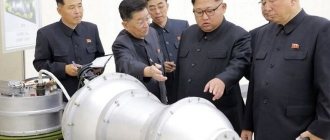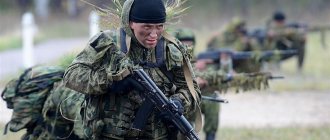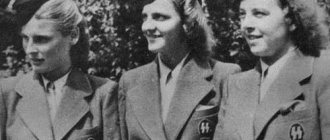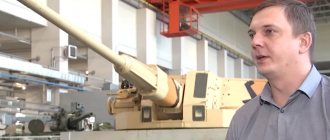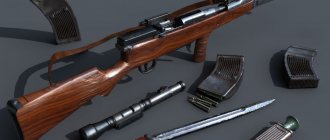14.07.2014
Airborne reconnaissance
Now that Western TV shows and films have flooded our media space, it may seem that Russia never had its own history and heroes. Trends from the West have done their job - now the younger generation knows about the American “Green Berets”, the British “SAS”, than about the brothers from Airborne Intelligence.
Airborne reconnaissance is rightfully considered the most prestigious component of the airborne forces, and there is a logical explanation for this - the guys from the airborne reconnaissance have proven themselves to be specialists of the highest class, whose profession is the impossible, airborne reconnaissance claims “only the stars are higher than us” - and this is not empty boasting.
Conducting reconnaissance operations requires high standards of physical and psychological preparation, so it is obvious that the reconnaissance units in the Airborne Forces are staffed with the best fighters. One glance at this photo of Airborne Forces reconnaissance is enough to understand that these cheerful guys will go to the end.
It is worth admitting that the guys from the military intelligence of the Airborne Forces have enough work. The guys always go first, realizing the full burden of responsibility that lies on them: if there is no information about the number of the enemy, about the state of the terrain, then the chances of a military operation for success will be close to failure. At the same time, airborne reconnaissance has a double responsibility: the guys must complete the task and remain unnoticed. It is no coincidence that the emblem of airborne reconnaissance is a bat - a symbol of mobility, secrecy and the horror that it inflicts on its enemies. By the way, the chevron with a bat worn by the guys from Airborne reconnaissance is also a symbol of the GRU special forces, which only further emphasizes the entire professionalism of Airborne reconnaissance.
General Margelov and Airborne Intelligence
The founder of the airborne forces, General Margelov, had a special attitude towards intelligence, because he himself commanded intelligence units during the Soviet-Finnish and Great Patriotic War.
Margelov put increased demands on them - after all, the airborne reconnaissance officers were the ones who had to be the first to come face to face with the enemy, to feel out what the enemy was like. Respecting all airborne troops, Margelov especially valued reconnaissance officers. There is a legend that it was with the light hand of Margelov that the bat became the emblem of the Airborne Forces reconnaissance.
It was under Margelov that airborne reconnaissance acquired a shape that remained unchanged until the mid-1980s. The functions of reconnaissance were: penetration into the enemy’s side, collection of intelligence information, damage to communications and communications. Later, after 1986, bats began to engage in operational reconnaissance - that is, going deep behind enemy lines in order to collect information used in planning and conducting combined arms operations. Previously, only the GRU was engaged in this type of reconnaissance, and this fact indicates how deeply the airborne reconnaissance was trusted by the Soviet command.
Airborne reconnaissance units in Afghanistan
In Afghanistan, a unique symbol of the USSR era after 1945, the 103rd Guards Airborne Division left a noticeable mark and wrote its name in golden letters in the book of military glory of the once great country. The 103rd Division was one of the first military units of the USSR deployed to Afghanistan in December 1979 and one of the last units to leave in 1989.
The 103rd's bats performed at their best in the Afghan conflict. Already in December 1979, they had to work in the city - airborne reconnaissance took an active part in the occupation of Kabul.
During the 10 years spent in Afghanistan, intelligence officers from the 103rd more than once went on a free search to collect information about local gangs, the presence of American and British instructors in their service, and to capture some local native prince. In general, Airborne reconnaissance had enough work. The spirits were in awe of the airborne reconnaissance officers, they were afraid of them like fire - what is not an example of the fact that reconnaissance in the airborne forces gave all its 200%? In unusual geographical conditions, under the scorching sun and high temperatures, bats persistently fulfilled their international duty, and only the stars were higher than them.
On Voenpro there are a lot of videos of airborne reconnaissance, you can also find footage from the life of the legendary 103rd reconnaissance.
Airborne reconnaissance in Russia
The military glory of sovereign Russia is inseparable from the history of the 45th Guards separate reconnaissance regiment of the Airborne Forces, created in 1994. At that time, the Russian army was going through hard times: devastation after the collapse of the USSR, lack of funds, and the departure of experienced officers from the army.
It’s a shame to remember, but equipment for reconnaissance of the Airborne Forces was collected in parts, at the expense of donations and money from sponsors. However, the resulting 45th regiment became an example of a unique special forces unit, it included unmanned reconnaissance equipment, and a psychological warfare department was created, which was supposed to carry out propaganda on enemy territory.
In parallel with this, it should be noted that since the first Chechen war, the tasks of airborne reconnaissance have changed, so bats began to conduct primarily search and combat activities, that is, searching for enemy units and destroying them on their own, without waiting for reinforcements to arrive.
Airborne reconnaissance officers from the 45th regiment showed themselves brilliantly in the first Chechen war; it was the airborne reconnaissance formations that were destined to be the first to begin the assault on Grozny in December 1994. Having served the entire Chechen campaign, the 45th Regiment departed back to the Moscow region to return to Chechnya again in 1999 and begin to restore order. Again, there is a story that gangs were removed from their posts if by some miracle they learned that bats were “working” in their area, so great was their horror of the guys from Airborne reconnaissance.
The world does not stand still, new threats arise in front of Russia, but even now we can say with confidence that if a tough confrontation with the enemy begins, airborne reconnaissance will be the first to meet the enemy, and the bats will do this filled with courage and high professionalism .
← Airborne Forces battles in Chechnya Airborne Forces training →
Intelligence methods
The methods of conducting ground tactical reconnaissance are: observation, eavesdropping, search, raid, ambush, interrogation, reconnaissance in force. Reconnaissance in force is an extreme, but effective measure in obtaining data on the number and weapons of the enemy. It is carried out by attacking the supposed camouflaged positions of the enemy, who has gone on the defensive, in cases where other means and methods of reconnaissance fail to obtain the necessary data about the enemy and his intentions. In military practice, reconnaissance in force is most often used if the operational situation requires the rapid advancement of troops
.
Time for a thorough analysis of the information obtained by tactical intelligence is limited, and it quickly becomes outdated. In this case, inaccurate or unreliable information can lead to large losses, and even to the defeat of the troops who used it.]
Gallery
- Marka867.jpg
Infantry on tanks and machine gunners depicted on the USSR postage stamp, 25 years of the Red Army and the Navy, 1918 - 1943
- USSR Motorized troops emblem.jpg
Sleeve insignia by branch of service: Motorized Rifle Troops of the USSR Armed Forces
- Error creating thumbnail: File not found
MSV sleeve patch
- SV-emblem.jpg
Motorized rifle (combined arms) lapel badge (since 2004)
- Motorizedriflerussia.jpg
Formation of a squad of soldiers of the Motorized Rifle Troops of the Ground Forces of the Russian Armed Forces. Photo by Vitaly Kuzmin
- SFportraits2010.jpg
Motorized rifleman in full combat gear, with an AK74M assault rifle and a PM/PMM pistol. Photo by Vitaly Kuzmin
Tactical reconnaissance in the Soviet Army
In the Soviet Army, as is customary in World Military Practice, tactical reconnaissance in the Ground Forces, Airborne Forces and Marine Corps was carried out by special reconnaissance units. The overlapping structure of tactical reconnaissance units was characteristic - starting with reconnaissance units in the battalion staff (as in the smallest basic independent tactical unit), for the level of each higher military formation (regiment/brigade/division/corps/army/district) there was a separate reconnaissance unit in the staff or a separate military unit. For motorized rifle
/
paratrooper
/
tank battalion
/
marine battalion,
a similar unit was
the Reconnaissance Platoon
(RV).
The task of the RV
was to collect intelligence data necessary to solve the combat missions assigned to
the battalion
.
The personnel of the RV
consisted of 16-21 fighters and consisted of three sections - two
reconnaissance sections
and one
engineering reconnaissance section
.
Reconnaissance platoons were introduced into battalions in the Soviet Army in the post-war period based on the experience of the Afghan War .
A. Volkov - 40th Army: history of creation, composition, changes in structure
:
...In October 1984, full-time reconnaissance platoons were formed in motorized rifle and airborne battalions...
Silent PB pistol - The standard weapon of the commander of a reconnaissance platoon (group
) in the Soviet Army
The machine guns and machine guns carried by the reconnaissance officers had a version with folding butts and straps for attaching night sights. In the 80s these were AKS-74N and RPKS-74N. Standard weapon of squad
there was an AKMSN assault rifle with a PBS silent firing device (at the end of the 80s, the troops began to receive PBS and subsonic cartridges for the AKS-74N, which made it possible to move to a single caliber of small arms in the department).
reconnaissance platoon
commander had a PB pistol as an additional service weapon.
In addition, the scouts were equipped with night sights, night vision devices, periscopes (scout tube), mine detectors, steeplejack equipment, camouflage robes and masks. NRS-2 - Scout Shooting Knife. Standard reconnaissance weapon in the Soviet Army TR-4 reconnaissance pipe - standard reconnaissance weapon for covert observation of the enemy
BRDM-2 is the main combat vehicle for tactical reconnaissance of motorized rifle troops of the Soviet Army. The Intelligence Department
was engaged in collecting information about the tactical situation necessary to solve combat missions assigned to the regiment/brigade.
Rota (
RR
).
The RR
consisted of two (for a regiment) or three (for a brigade)
Reconnaissance Platoons
and
a Company Directorate
- it consisted of personnel of 50-80 soldiers (the number depended on standard vehicles or armored vehicles).
Starting from the regiment level (or individual battalion
) and in all higher formations, there was a full-time position
of Chief of Intelligence
- an officer responsible for the collection and analysis of intelligence data.
At the level of a motorized rifle
/
tank division,
the collection of intelligence data was carried out by the Separate Reconnaissance Battalion (
ORB
), which was a separate military unit under the Division Headquarters.
The ORB
consisted of the Headquarters,
separate platoons
at the Headquarters and 4 companies -
the 1st and 2nd Reconnaissance Company
(
RR
),
the 3rd Reconnaissance and Landing Company
(
RDR
) and
the 4th Radio Interception Company
(
RRP
).
Soldiers of the 3rd RDR
underwent mandatory Airborne Training.
It was assumed that in the event of a full-scale war, to collect information about the enemy’s deep rear (the original name was the Deep Reconnaissance Company
), the landing
of RDR
by parachute by units of the Military Transport Aviation (
VTA
) attached to the division.
The 4th Radio Interception Company
was intended to constantly listen to enemy radio communications, and therefore officers and soldiers with knowledge of foreign languages were selected for the company's personnel, depending on the intended Theater of Military Operations.
For example, the personnel of the 4th Radio Interception Company of the 781st ORB of the
108th Motorized Rifle Division participating in the Afghan War consisted of 80% ethnic Tajik conscripts.
The ORB included separate platoons at the Battalion Headquarters - the Supply Platoon, the Communications Platoon and the Surveillance Reconnaissance Platoon (VRN). The tasks of the VRN were to monitor the enemy on the line of contact between troops, through powerful optical systems and using portable ground reconnaissance radar stations (for example, the 1RL133 PSNR-5 product). The 1st and 2nd Reconnaissance Company
within the ORB consisted of two
Reconnaissance Platoons
and
a Tank Platoon
.
The Tank Platoon
was intended for fire support during reconnaissance in force and was armed with PT-76 light amphibious tanks (for ORB as part of OKSVA - T-55/62) in the amount of 3 units.
Sleeve chevron of Separate Reconnaissance Battalions as part of OKSVA
3rd Reconnaissance and Landing Company
consisted of two
Reconnaissance Platoons
and one
Special Reconnaissance Platoon
(this platoon was intended to carry out reconnaissance and sabotage activities).
Each Reconnaissance Company
was armed with one multifunctional
Combat Reconnaissance Vehicle
BRM-1K, assigned to the company commander.
Regardless of which division ( tank
or
motorized rifle
) the ORB belonged to, its conscripts wore combined arms emblems (on buttonholes and a sleeve chevron).
ORB soldiers as part of OKSVA wore the emblems of tank forces. . Soldiers of the 3rd RDR
wore the emblems of the airborne troops on their buttonholes in red (motorized rifle division) or black (tank division)
. Organizational and Staffing Structure of the 781st Separate Reconnaissance Battalion of
the 108th Motorized Rifle Division in the fall of 1988. Organizational and Staffing Structure for the 1985th year of the
20th Separate Reconnaissance Brigade
. Group of Soviet troops in Mongolia
Due to the fact that the Airborne Forces were supposed to be used behind enemy lines, in contrast to the Ground Forces division, providing intelligence data at the level of the Airborne Division
(
VDD
) was handled by
the Separate Reconnaissance Company
(
ORR
), similar in staff to
the RR
in the regiment's staff.
In this case, the ORR
was a separate military unit under the Division Headquarters.
An example is the 80th ORR
(military unit 48121) under
the 103rd Guards Airborne Division
.
The Tactical Intelligence of the Soviet Army tested unique technical means of reconnaissance. These are complexes of reconnaissance and signaling equipment (anti-personnel seismic sounders with an automatic radio data transmitter) “Realiya-U” 1K18 and “Tabun” 1K124, which were successfully used during the Afghan War. In artillery, the concept of “Tactical Reconnaissance” is somewhat broader than in other branches of the military. . In addition to collecting information about the location of enemy forces, artillery reconnaissance also includes a detailed topogeodetic study of the area (Topogeodetic Combat Support), monitoring meteorological conditions in the combat zone and adjusting the fire of one’s own artillery. At the artillery battalion
(depending on the state), reconnaissance is carried out by
the Artillery Reconnaissance Platoon
(AR) on the staff of
the Control Battery
(CU) or a separate
Control Platoon
(CU) at the headquarters
of the artillery division
.
At artillery regiment
— the collection of intelligence data was carried out (depending on the staff of the military unit)
by the Artillery Reconnaissance Battery
(BAR) or
the Control and Artillery Reconnaissance Battery
(BUiAR).
The BAR/BUiAR consisted of a Control and Reconnaissance Platoon
(VUR),
a Meteorological Platoon
(MV),
a Sound Reconnaissance Platoon
(VZR) and
a Radar Reconnaissance Platoon
(VRLR
).
ARK-1 "Lynx" 1RL239 - the main radar complex for tactical reconnaissance of the artillery forces of the Soviet Army
Su-24MR is the main tactical reconnaissance aircraft of the USSR Air Force.
At the artillery brigade level, this was done by the Artillery Reconnaissance Division
(ARDn), consisting of
a Sound Reconnaissance Battery
(SRB),
a Radar Reconnaissance Battery
(RBR) and
a Topogeodetic Battery
(TB).
For artillery units of a motorized rifle/tank division
, in addition to the ORB, the collection of intelligence data was also carried out by the BUiAR at the Division Headquarters, which was a separate military unit.
An example is the 469th Control and Artillery Reconnaissance Battery
(military unit 84397) at the 201st MSD. For the artillery units of the combined arms armies of some Military Districts, the
Reconnaissance Army Artillery Regiment
(RAAP) was engaged in collecting intelligence data.
An example is the 1451st RAAP
(Leningrad Military District) or
the 2323rd RAAP
(Transcaucasian Military District).
Junior commanders (for sergeant positions) for artillery reconnaissance units were trained by the 932nd Training Reconnaissance Artillery Regiment
(Moscow Military District, Mulinsky Garrison).
At the Army/District level, additional collection of information about the tactical situation was carried out by aviation units of the Army/District subordination - Reconnaissance Aviation Regiments
(RAP).
They were assigned the function of operational aerial photography. For the USSR Armed Forces (with the exception of artillery troops and the Air Force), such a military formation as a reconnaissance regiment
.
The current 45th Separate Reconnaissance Regiment of the Airborne Forces ( 45th ORP
- from May 1, 1998 to August 2, 2005), at the disposal of the Commander of the Airborne Forces, was formed after the collapse of the USSR.
At the level of the Military District, in the event of a full-scale war, tactical reconnaissance functions (except for reconnaissance and sabotage activities deep behind enemy lines) were also assigned to Separate
Special Purpose
Brigades (
OBrSpN
- 14 brigades in total), partially subordinate to the GRU of the General Staff.
For reconnaissance units, the brigade was the largest military formation. It should be noted about a rare exception in the structure of reconnaissance formations. For 16 years, the USSR Armed Forces had unique reconnaissance brigades that had no relation to the GRU of the General Staff. These are the 20th and 25th separate reconnaissance brigades
as part of the Soviet troops in Mongolia.
These brigades consisted of 4 separate reconnaissance battalions, a separate artillery and a separate anti-aircraft missile and artillery division, a helicopter squadron and combat and logistics support units. A special feature of reconnaissance battalions was the presence of a tank company and a mortar battery. Such an unusual staff for reconnaissance units was explained by the vast desert-steppe territory in which the brigades had to conduct possible combat operations, which required them to have sufficient autonomy and the necessary firepower. Both brigades were actually formations that included separate military units with their own Battle Banners. Great importance was attached to the recruitment of personnel for reconnaissance units. Among the conscripts, the most physically fit and resilient were selected. Priority in the selection was mainly given to conscripts with sports categories in martial arts and athletics, and therefore situations often arose when almost the entire conscript composition of a separate reconnaissance company
in a regiment/brigade consisted of persons who had received the rank of First Class, Candidate Master of Sports before military service or Master of Sports.
For this reason, the Reconnaissance Companies
in the Soviet Army were unofficially called
“Sports Companies”
(not to be confused with the officially called
sports companies
at the district sports clubs of the Soviet Army - SKA).
A big role in this was played by the desire of the command of the military unit to be recognized by their own subordinates at all kinds of army sports competitions systematically held in the USSR Armed Forces at the level of division/district/branch/Armed Forces of the USSR. Officers for the reconnaissance units of the Soviet Army (including the special forces of the GRU and the Airborne Forces) were mainly trained at the intelligence department of the Kiev Combined Arms Command School
and at the special intelligence departments of the Ryazan Military Airborne Command School and the Novosibirsk Higher Military Command School.
Officers for artillery reconnaissance were trained mainly by the artillery reconnaissance departments of the 1st Leningrad Red Banner Artillery School
and the Kolomna Higher Artillery Command School
.
The main combat unit of the Motorized Rifle Brigade, motorized rifle battalion
The motorized rifle battalion, as the main tactical component of the brigade, includes three companies, one mortar battery and three platoons - grenade launcher, anti-tank and anti-aircraft missile. In addition, the motorized rifle battalion includes a signal platoon and a medical center.
The motorized rifle battalion, which numbers 539 military personnel, has at its disposal 43 armored personnel carriers, 42 vehicles, three Vasilek mortars, six 82-mm mortars, six Fagot anti-tank missile systems and nine Metis.
An excerpt characterizing the Motorized Rifle Troops of the Russian Federation
“I was very surprised when I heard about this,” said Prince Andrei. Pierre blushed the same way he always blushed at this, and hastily said: “I’ll tell you someday how it all happened.” But you know that it's all over and forever. - Forever? - said Prince Andrei. – Nothing happens forever. – But do you know how it all ended? Have you heard about the duel? - Yes, you went through that too. “The one thing I thank God for is that I didn’t kill this man,” said Pierre. - From what? - said Prince Andrei. – It’s even very good to kill an angry dog. - No, killing a person is not good, it’s unfair... - Why is it unfair? - repeated Prince Andrei; what is just and unjust is not given to people to judge. People have always been mistaken and will continue to be mistaken, and in nothing more than in what they consider just and unjust. “It is unfair that there is evil for another person,” said Pierre, feeling with pleasure that for the first time since his arrival, Prince Andrei became animated and began to speak and wanted to express everything that made him what he was now. – Who told you what evil is for another person? - he asked. - Evil? Evil? - said Pierre, - we all know what evil is for ourselves. “Yes, we know, but the evil that I know for myself, I cannot do to another person,” Prince Andrei said more and more animatedly, apparently wanting to express to Pierre his new view of things. He spoke French. Je ne connais l dans la vie que deux maux bien reels: c'est le remord et la maladie. II n'est de bien que l'absence de ces maux. [I know only two real misfortunes in life: remorse and illness. And the only good is the absence of these evils.] To live for yourself, avoiding only these two evils: that is all my wisdom now. – What about love for one’s neighbor, and self-sacrifice? - Pierre spoke. - No, I cannot agree with you! To live only in such a way as not to do evil, so as not to repent? this is not enough. I lived like this, I lived for myself and ruined my life. And only now, when I live, at least try (Pierre corrected himself out of modesty) to live for others, only now I understand all the happiness of life. No, I don’t agree with you, and you don’t mean what you say. Prince Andrei silently looked at Pierre and smiled mockingly. “You’ll see your sister, Princess Marya.” You’ll get along with her,” he said. “Maybe you’re right for yourself,” he continued, after a short silence; - but everyone lives in their own way: you lived for yourself and you say that by doing this you almost ruined your life, and you only knew happiness when you began to live for others. But I experienced the opposite. I lived for fame. (After all, what is glory? the same love for others, the desire to do something for them, the desire for their praise.) So I lived for others, and not almost, but completely ruined my life. And since then I have become calmer, as I live only for myself. - How can you live for yourself? – Pierre asked heatedly. - And the son, and the sister, and the father? “Yes, it’s still the same me, it’s not others,” said Prince Andrei, but others, neighbors, le prochain, as you and Princess Mary call it, are the main source of error and evil. Le prochain [Neighbor] are those, your Kyiv men, to whom you want to do good. And he looked at Pierre with a mockingly defiant gaze. He apparently called Pierre. “You’re kidding,” Pierre said more and more animatedly. What kind of error and evil can there be in the fact that I wanted (very little and poorly fulfilled), but wanted to do good, and at least did something? What evil can it be that unfortunate people, our men, people just like us, growing up and dying without any other concept of God and truth, like ritual and meaningless prayer, will be taught in the comforting beliefs of a future life, retribution, reward, consolation? What evil and delusion is it that people die from illness without help, when it is so easy to help them financially, and I will give them a doctor, and a hospital, and a shelter for an old man? And isn’t it a tangible, undoubted blessing that a man, a woman and a child have no rest day and night, and I will give them rest and leisure?...” said Pierre, hurrying and lisping. “And I did it, at least poorly, at least a little, but I did something for this, and not only will you not dissuade me that what I did was good, but you will also not disbelieve me, so that you yourself do not think so.” “And most importantly,” Pierre continued, “I know this, and I know it correctly, that the pleasure of doing this good is the only true happiness in life. “Yes, if you put the question like that, then that’s a different matter,” said Prince Andrei. - I build a house, plant a garden, and you are a hospital. Both can serve as a pastime. And what is fair, what is good - leave it to the one who knows everything, and not to us, to judge. “Well, you want to argue,” he added, “come on.” “They left the table and sat on the porch, which served as a balcony.
